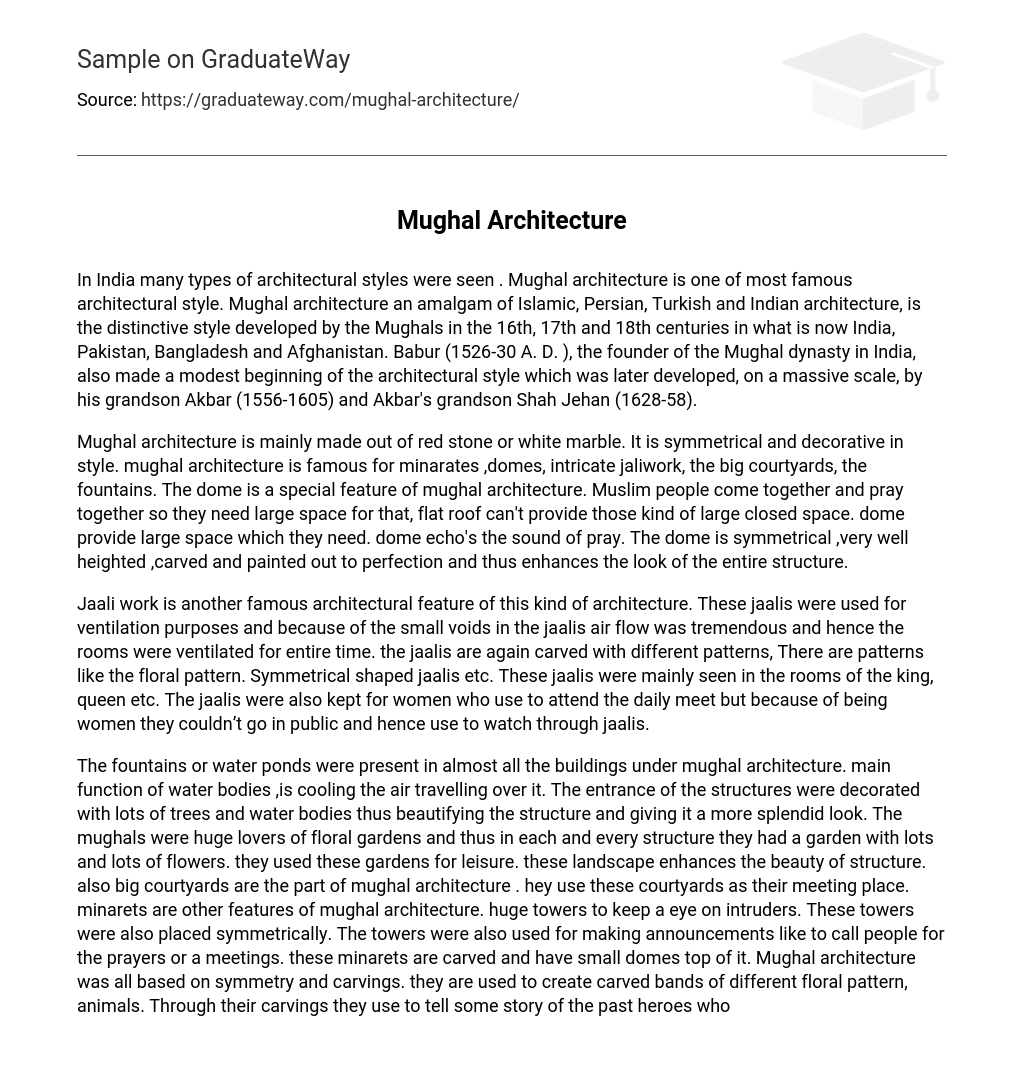In India many types of architectural styles were seen . Mughal architecture is one of most famous architectural style. Mughal architecture an amalgam of Islamic, Persian, Turkish and Indian architecture, is the distinctive style developed by the Mughals in the 16th, 17th and 18th centuries in what is now India, Pakistan, Bangladesh and Afghanistan. Babur (1526-30 A. D. ), the founder of the Mughal dynasty in India, also made a modest beginning of the architectural style which was later developed, on a massive scale, by his grandson Akbar (1556-1605) and Akbar’s grandson Shah Jehan (1628-58).
Mughal architecture is mainly made out of red stone or white marble. It is symmetrical and decorative in style. mughal architecture is famous for minarates ,domes, intricate jaliwork, the big courtyards, the fountains. The dome is a special feature of mughal architecture. Muslim people come together and pray together so they need large space for that, flat roof can’t provide those kind of large closed space. dome provide large space which they need. dome echo’s the sound of pray. The dome is symmetrical ,very well heighted ,carved and painted out to perfection and thus enhances the look of the entire structure.
Jaali work is another famous architectural feature of this kind of architecture. These jaalis were used for ventilation purposes and because of the small voids in the jaalis air flow was tremendous and hence the rooms were ventilated for entire time. the jaalis are again carved with different patterns, There are patterns like the floral pattern. Symmetrical shaped jaalis etc. These jaalis were mainly seen in the rooms of the king, queen etc. The jaalis were also kept for women who use to attend the daily meet but because of being women they couldn’t go in public and hence use to watch through jaalis.
The fountains or water ponds were present in almost all the buildings under mughal architecture. main function of water bodies ,is cooling the air travelling over it. The entrance of the structures were decorated with lots of trees and water bodies thus beautifying the structure and giving it a more splendid look. The mughals were huge lovers of floral gardens and thus in each and every structure they had a garden with lots and lots of flowers. they used these gardens for leisure. these landscape enhances the beauty of structure. also big courtyards are the part of mughal architecture . hey use these courtyards as their meeting place. minarets are other features of mughal architecture. huge towers to keep a eye on intruders. These towers were also placed symmetrically. The towers were also used for making announcements like to call people for the prayers or a meetings. these minarets are carved and have small domes top of it. Mughal architecture was all based on symmetry and carvings. they are used to create carved bands of different floral pattern, animals. Through their carvings they use to tell some story of the past heroes who fought for them etc. The floral patterns were the key patterns used for carvings.
The inside part of the domes were carved with such patterns thus making the structure look different from other forms of architecture. also the coloums are carved with stories and intricate work. large openings of structures with heighted arches shows the grandness of mughal architecture. The white marble or the red stone as we see was extensively used as these were the stones that were symbol of wealth. these stone is available in that locality. The big biog structures like the taj mahal Or the red fort were completely built by these stones. The white colour of taj mahal is the key feature of the structure.
All mughal structures are spread across large areas. like taj mahal ,fatehpur sikri, red fort. all these structures are famous for mughal architectural features. these structures have almost all features like gardens and water bodies surrounded by structures, minarets, domes, jalli works . Thus mughal architecture should be studied to know what exactly symmetry means and hw do their domes, jaalis correspond to their form of architecture, this form of architecture has a great impact on the other types of architecture in India and the word symmetry has made a new stand in the books of architecture because of such buildings.





